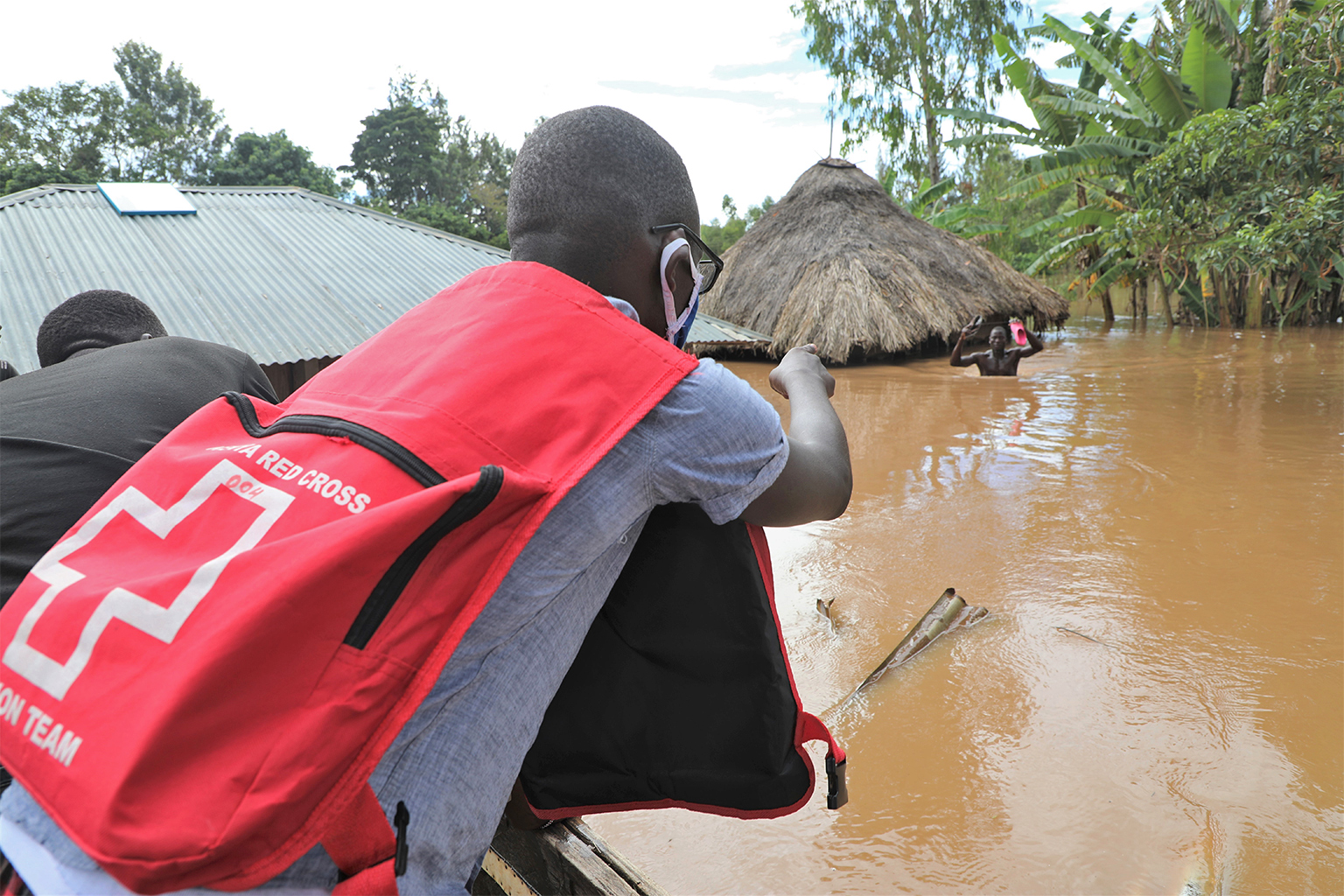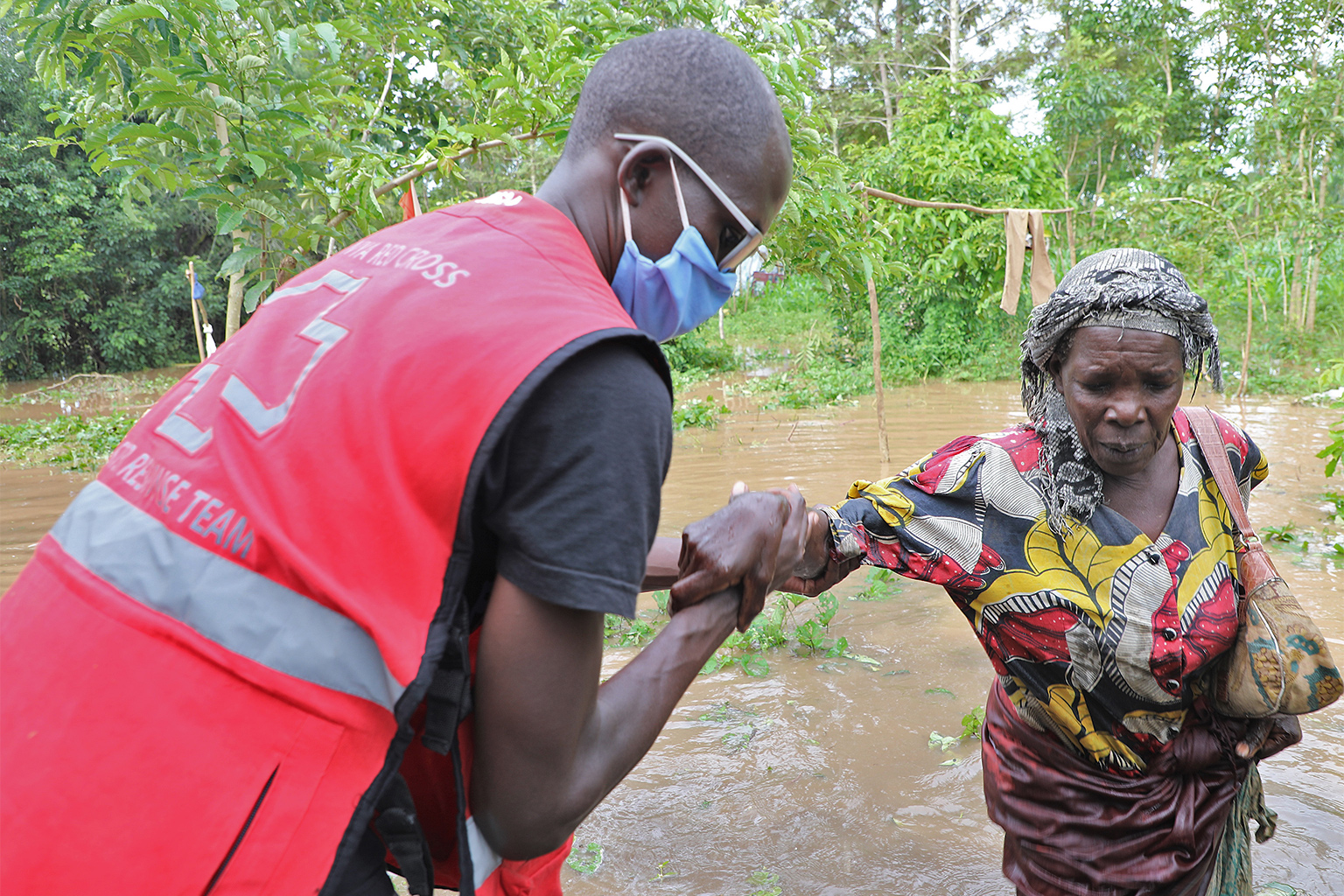- Globally, humanitarian aid workers are facing complex climate and health crises that require urgent adaptations within a shrinking humanitarian space, according to a recent piece in the Lancet.
- About 274 million people worldwide are now in need of humanitarian assistance — up from 235 million in 2021 — as climate emergencies intensify.
- In Kenya, families on the shores of Lake Victoria were displaced at the peak of the COVID-19 pandemic and humanitarian organizations played a key role in supporting villagers to cope with the dual shocks.
- Data from Children Service Department show that currently, at least 3,420 children and 12 households in the Lake Victoria area are headed by children living in makeshift camps.
As climate change intensifies across the world, humanitarian responses must urgently adapt to “cascading crises” with unprecedented consequences that put millions at risk of famine and death, a group of humanitarian and public health experts warns.
Their commentary, published in The Lancet in October, illustrates how the climate emergency is a humanitarian and health crisis and an increasing threat to the human population evidenced by extreme weather events, changes in water quality and quantity and declining food security.
These complex crises are hitting simultaneously — from extreme weather events to political instability, worsening poverty and inequality, epidemics and hunger; all of which compound the need for strengthened emergency management and response.
The Lancet piece estimates about 274 million people worldwide are now in need of humanitarian assistance — which has increased from 235 million in 2021.

According to the commentary, humanitarian needs will increase exponentially as poverty and food insecurity rise, the global supply chain and energy crises intensify, sociopolitical instability worsens, the collateral effects of COVID-19 become more apparent, and the intensity and frequency of climate-related events increase.
The authors note that the increasing needs occur within a shrinking humanitarian space characterized by underfunding and high rates of violence against workers. The commentary depicts the harsh realities that many humanitarian workers face amid crises.
One particular example is the humanitarian response to perennial flooding as a result of rising water levels in Lake Victoria, in Kenya. There, the workers who speak to Mongabay confirm they have had to change their ways of responding to the situation using limited resources — including human resources.
According to Kenya Red Cross regional manager Hellen Cheruto, there is a recent increase in the number of people displaced by floods. A UNDP report titled Rising Water Levels in Kenya’s Rift Valley Lakes and Lake Victoria shows that at least 37,140 families were displaced by floods on the shores of lake Victoria, which have been rising since 2019.
The families were displaced at the peak of the COVID-19 pandemic in Kenya and humanitarian organizations played a key role in supporting villagers to cope with the dual shocks.

As a result of the backflow of the lake, the dikes were unable to contain a flood that was the worst in the area since the 1960s, Cheruto says. She blames the flooding on a combination of factors, including climate change, urbanization and farming.
While limited resources were available, the floods tripled the amount of emergency humanitarian assistance provided by the Red Cross, including hygiene and sanitation facilities and psychosocial support.
The UNDP report demonstrates the extent of destruction of human settlements and livelihoods, and how farmlands and grazing lands, including critical infrastructures such as buildings, roads, electricity and bridges, were submerged.
According to current Red Cross data, 15 villages are still submerged with 966 families still living in makeshift camps.
In 2020, the organization responded to about 17,000 households, which was a sharp increase compared with previous years in which the team could respond to a maximum of 3,000 households.

Red Cross workers provided shelter and mobility devices to those with special needs — people who are most vulnerable to climate crises and most neglected by climate action. The organization is currently considering cash transfers for this group of people instead of food and non-food provisions.
“In the course of work, our limited staff experience stress and depression from the scenes they come across, and because our numbers are limited; we reach out to volunteers in communities to support our course,” Cheruto says.
“These families are in dire need of humanitarian assistance; we have constraints in providing food and non-food items, but we try our best to help the families,” she says.
Her experience in Kenya reflects precisely the sort of “cascading crises” highlighted by the authors of The Lancet commentary. They recommend that the humanitarian sector, as a whole, must deliver flexible responses, embed high levels of uncertainty into their operating environments and work to reduce their own environmental footprints.
To that end, Cheruto says her organization has reduced travel and implemented video conferences to reduce its carbon footprint. Furthermore, they control the power and heat in their buildings.
“Besides recycling paper and plastics, we also inform all staff and volunteers about our environmental and carbon reduction policies,” she says.

Cheruto adds that working with Kenya’s meteorological department has helped the organization prepare to respond to unpredictable weather conditions, especially in flood-prone areas, and adjust to environmentally friendly activities to minimize their carbon footprints.
Thus, the Red Cross provides eco-friendly tents and items that affected communities can utilize fully, eliminate disposable products and distribute products with less packaging.
“Anticipatory action (including emergency warning and preparedness for multihazard events) should be implemented to reduce the effects and strengthen the management of complex emergencies,” according to The Lancet commentary.
Just as Kenya’s humanitarian workers are experiencing, the Lancet commentary reveals how climate change is a threat multiplier, increasing the risk of climate-related crises, conflict and displacement. Climate change is also a major driver of food insecurity, which has been increasing globally for the last six years.
The UN’s latest annual report on food security and nutrition, published in July, shows that hunger affected 828 million people worldwide in 2021, an increase of about 46 million since 2020 and 150 million since COVID-19 spread.
The report shows that the world is unlikely to achieve its 2030 goal of ending hunger, food insecurity and malnutrition.
Furthermore, according to the Lancet piece, food insecurity is a known catalyst for democratic breakdown and conflict. Meanwhile, worsening environmental conditions also lead to population displacement. In 2020, more than 30 million people, including children, were displaced due to climate-related factors worldwide.

UNICEF field office chief for Kenya, Wangui Karanja, says children are hard-hit by the sorts of floods on the shores of Lake Victoria. Data from the local government’s Children Services Department show that currently at least 3,420 children and 12 households are headed by children living in makeshift camps.
“This is a vulnerable population that needs special care, and we try to offer support to ensure that the children are safe,” Wangui says.
The Lancet commentary also recommends transdisciplinary collaborations to stem and respond to the cascading effects of crises across societies. Local communities must be involved in activities that boost their creative solutions in response to climate change.
The authors cite poor coordination between national responses and local communities and recommend strengthening the interagency coordination, monitoring and reporting mechanisms on climate change and action so as to ensure effective resource use.
According to Nancy Okoth, a project manager at Plan International Kenya, which has also responded to floods on the shores of Lake Victoria, the organization has confronted the barriers while responding to crisis.
“At times poor coordination has left many without help, and in return, making it difficult for humanitarian organizations to perform their work effectively,” she says.
She explains that poor coordination has led to vulnerable groups such as children, pregnant and lactating mothers, people with chronic illnesses and people living with disabilities missing out on critical help.
Officials from the organization observe an increasing demand for both food and non-food items each time the region experiences floods.
“Getting adequate resources to respond to an abrupt increase in the number of displaced people is very straining, and we try to reach out to other partners to fill the gap,” Okoth says.
The Lancet commentary notes the need for governments to invest in climate change adaptations, adding that governments most responsible for the climate crisis “must bear the biggest burden of repair.”
“Climate mitigation must be an utmost priority to ensure a livable future,” the authors write.
Banner image: Kenya Red Cross volunteer rescuing resident of Nyadorero Center, Kamalunga Village, Siaya County during the floods response. Image courtesy of John Bundi/Kenya Red Cross.
Sinkholes emerge in rural Kenya after series of floods, droughts
Citations:
Baxter, L., McGowan, C. R., Smiley, S., Palacios, L., Devine, C., & Casademont, C. (2022). The relationship between climate change, health, and the humanitarian response. The Lancet, 400(10363), 1561-1563. doi:10.1016/s0140-6736(22)01991-2
Republic of Kenya. (2021). Rising Water Levels in Kenya’s Rift Valley Lakes,Turkwel Gorge Dam and Lake Victoria a Scoping Report-the Short-Popular-Version. Retrieved from UNDP website: https://ir-library.ku.ac.ke/handle/123456789/22854?show=full
FAO; IFAD; UNICEF; WFP; WHO. (2022). The State of Food Security and Nutrition in the World. Retrieved from Food and Agriculture Organization of the United Nations website: https://www.fao.org/3/cc0639en/cc0639en.pdf
